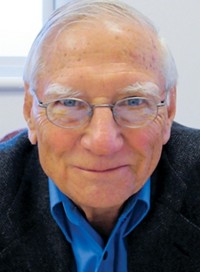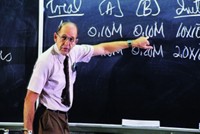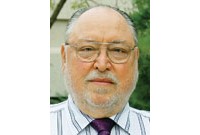Advertisement
Grab your lab coat. Let's get started
Welcome!
Welcome!
Create an account below to get 6 C&EN articles per month, receive newsletters and more - all free.
It seems this is your first time logging in online. Please enter the following information to continue.
As an ACS member you automatically get access to this site. All we need is few more details to create your reading experience.
Not you? Sign in with a different account.
Not you? Sign in with a different account.
ERROR 1
ERROR 1
ERROR 2
ERROR 2
ERROR 2
ERROR 2
ERROR 2
Password and Confirm password must match.
If you have an ACS member number, please enter it here so we can link this account to your membership. (optional)
ERROR 2
ACS values your privacy. By submitting your information, you are gaining access to C&EN and subscribing to our weekly newsletter. We use the information you provide to make your reading experience better, and we will never sell your data to third party members.
People
George C. Pimentel Award In Chemical Education
by Corinna Wu
February 23, 2015
| A version of this story appeared in
Volume 93, Issue 8
Sponsored by Cengage Learning and the ACS Division of Chemical Education
The impact that I. Dwaine Eubanks, professor emeritus at Clemson University, has had on the world of chemistry education reaches far and wide. Active in the ACS Division of Chemical Education, including a stint as its chair in 1985, he has helped to develop innovative chemistry curricula, authored and illustrated textbooks, and pioneered new methods of chemistry assessment.
Eubanks grew up as “a nerdy kid” in the oil patch of West Texas and set off for the University of Texas, Austin, receiving a bachelor’s degree in chemistry in 1960.
The draft was in effect at that time, Eubanks says, so he decided to continue at UT Austin to work toward a Ph.D. in inorganic chemistry. After earning his degree in 1963, he spent four years at DuPont doing research in actinide chemistry. “DuPont was a really great company to work for, but I realized early on that I was basically an academic at heart,” he says. So he began his academic career at Oklahoma State University.
With encouragement from the department chair, Eubanks became director of Oklahoma State’s general chemistry program. At that point, he believed he could benefit from forging connections with a bigger network of educators. “That’s when I really started becoming active in chemistry education,” he says.
Once he got involved, Eubanks says, “it was like a big vortex; it just sucked you in.” Over the years, he worked on several big curriculum projects, including “ChemCom: Chemistry in the Community,” from 1983 to 1986. ChemCom, an innovative high school textbook funded by the National Science Foundation and ACS, teaches chemistry from an issue-centered perspective. “Rather than starting with chemical principles, you started with a real-world problem, then developed the chemistry to address that problem,” Eubanks explains. He led a chapter-writing team, served on the editorial board, and also organized field centers to train teachers in the curriculum. ChemCom found a lot of success in the U.S., was translated into several languages, and served as a prototype for curriculum development projects in other countries.
Eubanks also lent his talents in graphic design to the ACS-sponsored college textbooks “Chemistry in Context” and “Chemistry.” In reviewing earlier editions, he noticed errors in many of the illustrations. When he brought these errors to the attention of the publisher, it enlisted Eubanks to do the technical illustrations for the new editions.
Eubanks’s work also helped give teachers better tools to assess their students’ grasp of chemical concepts. From 1988 to 2001, Eubanks was director of the ACS Examinations Institute. There, he spearheaded efforts to put improved testing methods and assessment techniques into practice. He took the Examinations Institute with him to Clemson University in 1992 after receiving a call with a job offer he “just couldn’t turn down.” He spent 11 years there and retired in 2003.
“The breadth of his contributions to chemical education is truly extraordinary,” according to Mary Virginia Orna, a professor of chemistry at the College of New Rochelle, in New York.
Eubanks, 76, was corecipient of the first award for outstanding service from the ACS Division of Chemical Education and was elected a fellow of ACS in 2012.
Eubanks will present his award address before the Division of Chemical Education.






Join the conversation
Contact the reporter
Submit a Letter to the Editor for publication
Engage with us on Twitter